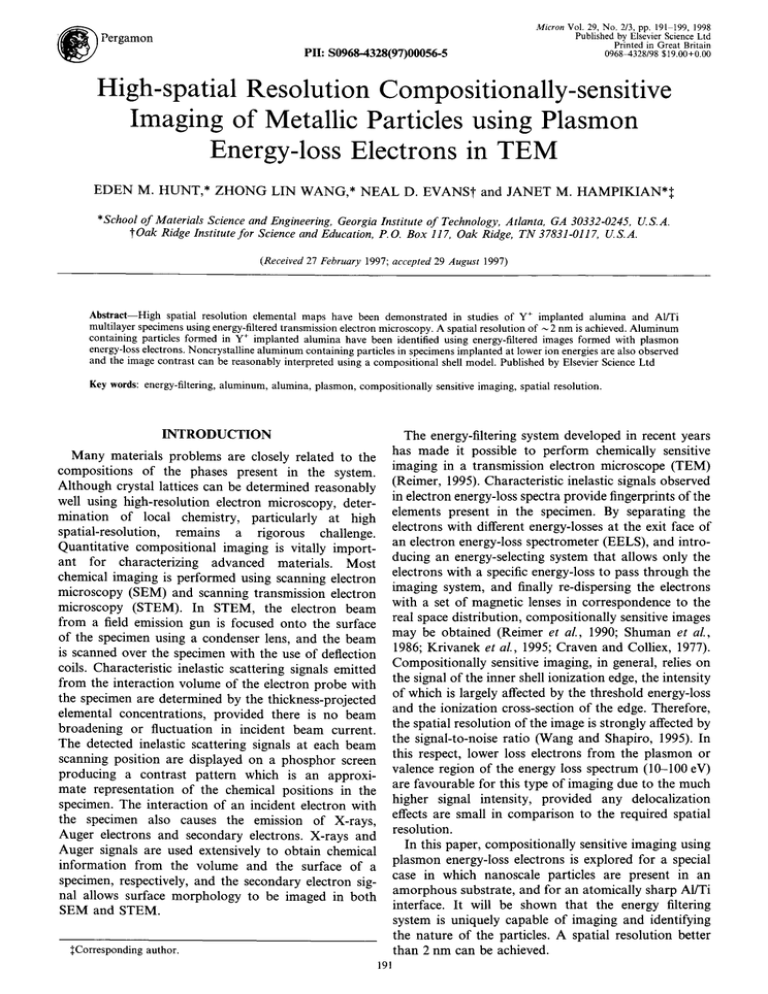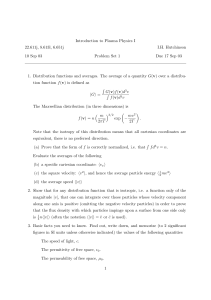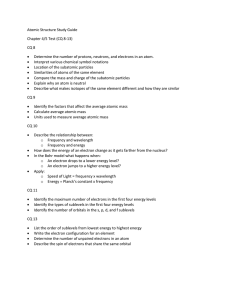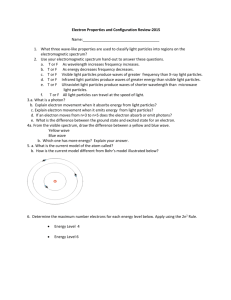Vol. 29, No. 2/3, pp. 191 199, 1998
advertisement

Micron Vol.29, No. 2/3,pp. 191 199,1998
~ )
Pergamon
PII: S0968-4328(97)00056-5
Publishedby ElsevierScienceLtd
Printedin GreatBritain
09684328/98 $19.00+0.00
High-spatial Resolution Compositionally-sensitive
Imaging of Metallic Particles using Plasmon
Energy-loss Electrons in TEM
EDEN M. HUNT,* ZHONG LIN WANG,* NEAL D. EVANSt and JANET M. HAMPIKIAN*$
*School of Materials Science and Engineering, Georgia Institute of Technology, Atlanta, GA 30332-0245, U.S.A.
t Oak Ridge Institute for Science and Education, P.O. Box 117, Oak Ridge, TN 3 7831-0117, U.S.A.
(Received 27 February 1997;accepted 29 August 1997)
Abstract--High spatial resolution elemental maps have been demonstrated in studies of Y+ implanted alumina and A1/Ti
multilayerspecimensusingenergy-filteredtransmissionelectronmicroscopy.A spatialresolutionof ~ 2 nm is achieved.Aluminum
containing particles formed in Y+ implanted alumina have been identifiedusing energy-filteredimages formed with plasmon
energy-losselectrons.Noncrystallinealuminumcontainingparticlesin specimensimplantedat lowerion energiesare also observed
and the imagecontrastcan be reasonablyinterpretedusing a compositionalshellmodel. Publishedby ElsevierScienceLtd
Key words: energy-filtering,aluminum,alumina,plasmon,compositionallysensitiveimaging,spatial resolution.
INTRODUCTION
The energy-filtering system developed in recent years
has
made it possible to perform chemically sensitive
Many materials problems are closely related to the
imaging
in a transmission electron microscope (TEM)
compositions of the phases present in the system.
(Reimer,
1995). Characteristic inelastic signals observed
Although crystal lattices can be determined reasonably
in
electron
energy-loss spectra provide fingerprints of the
well using high-resolution electron microscopy, deterelements
present
in the specimen. By separating the
mination of local chemistry, particularly at high
electrons
with
different
energy-losses at the exit face of
spatial-resolution, remains a rigorous challenge.
an
electron
energy-loss
spectrometer
(EELS), and introQuantitative compositional imaging is vitally importducing
an
energy-selecting
system
that
allows only the
ant for characterizing advanced materials. Most
electrons
with
a
specific
energy-loss
to
pass
through the
chemical imaging is performed using scanning electron
imaging
system,
and
finally
re-dispersing
the
electrons
microscopy (SEM) and scanning transmission electron
with
a
set
of
magnetic
lenses
in
correspondence
to the
microscopy (STEM). In STEM, the electron beam
real
space
distribution,
compositionally
sensitive
images
from a field emission gun is focused onto the surface
of the specimen using a condenser lens, and the beam may be obtained (Reimer et al., 1990; Shuman et al.,
is scanned over the specimen with the use of deflection 1986; Krivanek et al., 1995; Craven and Colliex, 1977).
Compositionally sensitive imaging, in general, relies on
coils. Characteristic inelastic scattering signals emitted
from the interaction volume of the electron probe with the signal of the inner shell ionization edge, the intensity
the specimen are determined by the thickness-projected of which is largely affected by the threshold energy-loss
elemental concentrations, provided there is no beam and the ionization cross-section of the edge. Therefore,
broadening or fluctuation in incident beam current. the spatial resolution of the image is strongly affected by
The detected inelastic scattering signals at each beam the signal-to-noise ratio (Wang and Shapiro, 1995). In
this respect, lower loss electrons from the plasmon or
scanning position are displayed on a phosphor screen
producing a contrast pattern which is an approxi- valence region of the energy loss spectrum (10--100 eV)
mate representation of the chemical positions in the are favourable for this type of imaging due to the much
higher signal intensity, provided any delocalization
specimen. The interaction of an incident electron with
effects are small in comparison to the required spatial
the specimen also causes the emission of X-rays,
Auger electrons and secondary electrons. X-rays and resolution.
In this paper, compositionally sensitive imaging using
Auger signals are used extensively to obtain chemical
plasmon
energy-loss electrons is explored for a special
information from the volume and the surface of a
case
in
which
nanoscale particles are present in an
specimen, respectively, and the secondary electron sigamorphous substrate, and for an atomically sharp AI/Ti
nal allows surface morphology to be imaged in both
interface. It will be shown that the energy filtering
SEM and STEM.
system is uniquely capable of imaging and identifying
the nature of the particles. A spatial resolution better
$Corresponding author.
than 2 nm can be achieved.
191
192
E . M . H u n t et al.
EXPERIMENTAL METHODS
Single crystal alumina (-1-123) was ion implanted at
ambient temperature with either 100 or 170 keV singly
charged yttrium ions to a fluence of 5 x 1016 ions/cm 2.
Planar view specimens were prepared for TEM observations using standard dimple grinding and ion beam
milling techniques. Energy filtered transmission electron
microscopy experiments were performed with a Gatan
Imaging Filter (GIF ~) interfaced to a Philips CM30
TEM operated at 300 kV. The low-loss images were gain
normalized, 512 x 512 pixels in size and were recorded
with an exposure time of 1 s and an energy-selecting
window of 5 eV. Images acquired using core-loss
electrons were recorded with an exposure time of 30 s
and an energy-selecting window of 30 eV. Additional
information was obtained by electron diffraction, bright
field imaging and energy dispersive X-ray spectroscopy
with an oxygen sensitive detector in a Hitachi HF-2000
TEM operated at 200 kV.
AI/Ti polycrystalline multilayer specimens were prepared by sputtering as described in detail elsewhere
(Shechtman et al., 1994). Cross-sectional TEM specimens were prepared which provided atomically sharp,
epitaxial interfaces. The A1/Ti specimen was imaged
using a JEOL 3010 TEM at 300 kV equipped with a GIF
system. Some of the EELS spectra were acquired using a
Hitachi HF-2000 TEM operated at 200 kV.
---....
___
/1-\
..
iI
/
.
---~,. ,
'~'~//"'""/;/-'\X
Aluminum
Alumina
Yttria
y Implant
'"
\
00.0
10.0
20.0
i
I
I
30.0
Energy
40.0
50.0
60.0
Fig. 1. A comparison of EELS spectra acquired from an
a l u m i n u m foil, alumina, yttria and a yttrium implanted alumina sample for selecting the characteristic peaks which might
be used for forming energy-filtered images. The implanted
sample spectrum has been offset along the y-axis for clarity.
viewing, contains both the broad A1203 feature at 24 eV
and the sharper peak at 15 eV. This comparison of
spectra indicates that energy-filtered images formed
using the electrons with energy-losses of 15 eV, 25 eV
and 40 eV may yield information about the chemical
nature of the nanostructures formed during this ion
implantation.
A zero-loss electron image of an implanted area is
shown in Fig. 2(a). In this image the particles present in
the sample are not apparent and the gradual contrast
variation is due to the increasing thickness of the
COMPOSITIONALLY SENSITIVE IMAGING
sample. Imaging with 15eV energy-loss electrons
The first specimen examined was single crystal (Fig. 2(b)), using a 5 eV energy window, revealed
alumina implanted at ambient temperature with 100 keV particles within in the alumina matrix. These particles
Y+ to a fluence of 5 x 1016 ions/cm 2. Ion channelling, have sizes which range from 20-100nm. A striking
Knoop microhardness measurements, and transmission phenomenon is the fine 4-10 nm substructure within
electron microscopy (TEM) all indicate that the alumina the particles, possibly indicating compositional
surface layer was amorphized by the implantation (Hunt gradients within the particles. In the image formed by
et al., 1996a, 1996b; Hunt and Hampikian, 1997). Bright the 25 eV energy-loss electrons (Fig. 2(c)), the bright
field TEM revealed a lack of diffraction contrast in this features (particles) observed in Fig. 2(b) are darker than
sample and displayed only a diffuse electron diffraction the surrounding matrix. This result indicates that these
haze associated with the presence of an amorphous particles are not composed of alumina. In addition,
phase. However, an optical absorption feature in the the image recorded using the 40 eV energy-loss electrons
near ultraviolet indicated the presence of nanostructures (Fig. 2(d)) also shows the particles with a lower
in this sample. For this reason energy-filtered imaging intensity than the surrounding matrix material. As diswas carried out in order to image these nanostructures cussed above, the 38 eV edge is only present in the
(Evans et al., 1995). Before presenting the energy- spectrum of Y 2 0 3 , thus, this image confirms that the
filtered images an understanding of the valence/plasmon particles are not yttria. All of these images support
electron energy loss patterns of the elements involved the conclusion that these particles are neither alumina
is instructive. Single-scattering energy-loss spectra nor yttria.
Similar investigations on another specimen which was
from standard specimens (Ahn and Krivanek, 1983) of
implanted
with 170 keV Y+ to a fluence of 5 x 1016
alumina (A1203), aluminum (A1) and yttria (7203) are
shown in Fig. 1; these are all possible components of this ions/cm 2 resulted in comparable images. The zero-loss
system. The strong peak at about 38 eV is the Y-N2, 3 filtered image (Fig. 3(a)) shows very weak contrast from
ionization edge. Both the A1 and Y203 spectra show some of the crystalline particles contained in this sample.
a loss feature at 15 eV and the A1203 spectrum has a The 25 eV loss image (Fig. 3(c)) demonstrates that these
broad feature centered at approximately 24eV. A particles are not alumina, while the image recorded from
typical energy loss spectrum from one of the yttrium the 15 eV energy-loss electrons (Fig. 3(b)) shows many
implanted alumina samples is also shown in Fig. 1. This more particles than are apparent in the other images.
spectrum, which is offset along the y-axis for ease of This is in agreement with the observations shown in
High-spatial Resolution Compositionally-sensitiveImaging of Metallic Particles
193
,E=0
Fig. 2. (a) Zero-loss, (b) 15 eV plasmon-loss,(c) 25 eV plasmon-lossand (d) 40 eV peak energy-selectedTEM imagesfrom the same
specimen region of a 100 keV Y÷ implanted alumina specimen. The energy selection window was centered at these energies
specified and its width was 5 eV.
Fig. 2, with the exception that these particles demonstrate little or no substructure. The particle sizes are in
the range of 10-15 nm, much smaller than those shown
in Fig. 2, despite being the result of the implantation of
an identical amount of yttrium (5 x 1016 ions/cm2). An
oxygen 'jump-ratio' image (post O - K edge divided by
pre O - K edge) from the same area (Fig. 3(d)) shows that
the particles are deficient in oxygen with respect to the
surrounding matrix material. This result also agrees with
previous energy dispersive X-ray spectroscopy (EDS)
194
E.M. Hunt et al.
&E = 25 eV
Fig. 3. (a) Zero-loss,(b) 15 eV plasmon-loss, (c) 25 eV plasmon-loss and (d) oxygenjump ratio energy-selectedTEM images from
the same specimen region of a 170 keV Y÷ implanted alumina specimen. The energy selection window was centered at these
energies specifiedand its width was 5 eV.
analysis which showed that the particles are oxygen
deficient with respect to the matrix material (Hunt e t al.
1996a, 1996b; Hunt and Hampikian, 1997).
To finalize our identification of the nature of the
observed particles, EELS spectra were acquired using
electrons transmitted through the particles, the matrix
and a standard thin film specimen of A1 with surface
oxidation, as shown in Fig. 4(a). It is apparent that the
15 eV l~eak observed in the spectrum from the particle
bearing region agrees well with the volume plasmon
peak of metallic A1, and there is no detectable metallic
A1 in the matrix. The 25 eV peak observed in the
High-spatialResolutionCompositionally-sensitiveImagingof MetallicParticles
A: Particle
B: Matrix
C: Oxidized AI firm
4-
O
O
O
X
~3¢0
o
"0
0
2.
195
a=0.41 nm+0.03nm, is in good agreement with the
diffraction measurements. Therefore, the similarity
between the particle crystallography and that of pure
aluminum (which is FCC with a lattice parameter of
0.404nm), in conjunction with the EFTEM results
suggests that the particles are metallic aluminum nanocrystals with a slightly dilated lattice parameter, possibly
due to the incorporation of a small amount of yttrium.
0
21
SPATIAL RESOLUTION
2'0
40
60
8'0
Energy Loss (eV)
3000-
b
2500.
t-
8 2000-
.g 15000
s:
1000O_
5000
-0
20
40
60
80
Energy Loss (eV)
Fig. 4. Energy-lossspectra from (A) an embeddedparticle and
(B) the adjacentamorphousmatrixfor (a) a large particle and
(b) a smallparticle, wherethe spectrumC was acquiredfrom a
standard thin A1foilcoveredby aluminaoxidationlayers.
standard A1 specimen is due to the volume excitation of
the unavoidable alumina oxidation layer at the top and
bottom surfaces of the metal film. The spectra from the
embedded particle and the oxidized A1 standard are
quite similar in major characteristics, allowing the
conclusion that the observed particles are metallic A1.
Fig. 4(b) shows a comparison of two spectra acquired
from a small size ( ~ 5 nm) particle and its adjacent
matrix. The intensity of the 15 eV peak in the particle's
spectrum is significantly reduced due to the smaller
particle size which results in a decrease in the amount of
thickness-projected metallic A1 in the beam illumination
region.
The particles formed in the alumina matrix implanted
with 170 keV Y÷ clearly show solid contrast with no
substructure. In addition, these particles are crystalline.
Electron diffraction patterns recorded from a large
area have been used to determine the lattice constant of
the particle material, with the aid of a standard Au
diffraction pattern recorded under the same imaging
conditions. The particles have an FCC structure with
a lattice parameter of a=0.411 ±0.002 um (Fig. 5(a)).
High resolution lattice images of the particles were
used to carry out an independent calculation of the
lattice parameter (Fig. 5(b)). The particle in Fig. 5 is
oriented along [011], and the lattice parameter
As observed in Fig. 2, the Al-rich particles show
contrast suggestive of compositional gradients present in
the particles. To estimate the optimum spatial resolution
that can be achieved using plasmon energy-loss electrons, image processing is carried out. This processing
consists of subtracting the contribution of the alumina
matrix from the 15 eV-loss image. This contribution was
estimated using adjacent loss images and subtracted
from the original 15 eV-loss image (Evans et aL, 1995).
Fig. 6(a) shows a processed 15 eV energy-filtered image
from the specimen implanted with 100 keV Y÷. A line
scan across a particle (indicated by a line in Fig. 6(a)) is
shown in Fig. 6(b). This line scan contains two peaks
representing the intensity of the particle image along the
indicated line. The full width at half maximum of this
intensity is measured to be W=3.7 + 0.3 nm. This value
includes not only the finite width of the A1 wall but also
the contrast blurring due to the delocalization effect in
plasmon excitation.
In this implanted sample both the particles and the
surrounding matrix are amorphous, therefore it is
difficult to use conventional imaging or diffraction techniques to estimate the local thickness of the A1 substructure present in these particles. Therefore, another
specimen with a known interface structure was used to
determine the spatial resolution that can be expected
using 15 eV loss electrons. In practice, it is impossible
to preserve a metallic A1 surface without oxidation in
conventional TEM with a vacuum of 10 7-10-8 Torr in
the column. The interface studies were carried out using
a cross-sectional Ti/A1 multilayer sample. Fig. 7(a) and
(b) show a pair of high-resolution lattice images of an
A1/Ti (111) interface recorded using zero-loss and A1
plasmon-loss electrons, respectively. The A1/Ti interface
is atomically sharp and is oriented parallel to the incident beam direction. It is apparent that the crystal lattice
fringes are resolved in the image recorded using the
inelastically scattered electrons. The overall contrast of
the plasmon-loss energy-selected image may provide
compositionally sensitive information, but the lattice
fringes are still governed by phase contrast (Wang,
1997), as in conventional HRTEM. Therefore, the
bright fringes do not necessarily represent the A1 (or Ti)
atomic planes.
To estimate the spatial resolution of the plasmon-loss
electron image, a line scan is made across the A1/Ti
interface, and the result is shown in Fig. 7(c). The fine
oscillation in the intensity profile is due to the lattice
fringes. The intensity profile drops within a distance of
196
E.M. Hunt et al.
Fig. 5. (a) A selected area electron diffraction pattern and (b) a high-resolution TEM image of a single solid particle from a 170 keV
Y+ implanted alumina specimen.
2000
11.6
nm
~
1000
0
Fig. 6. (a) A background subtracted 15 eV plasmon-loss energy-filtered TEM image showing only the contribution of the metallic
A1 (b) A line scan across particle A (indicated in (a)) for the estimation of the thickness of the A1 wall.
3 nm around the interface. Thus, the spatial resolution is
approximately ri=l.5 to 1.8 nm. This spatial resolution
is determined by the non-localized scattering of valence
electrons (Wang and Shapiro, 1995). Using this value,
the thickness of the A1 structure in the particles shown in
Fig. 6(b) is estimated to be Ad~ W-ri~2.1-t-0.4 nm.
High-spatial Resolution Compositionally-sensitive Imaging of Metallic Particles
C
•
8000
6000
,ooo
C
•
8s
E ~ 2o0o
~13 03
<.__
AI
Ti
',
•
-3
-2
!
-1
0
1
Distance x (nm)
•
!
2
•
3
Fig. 7. (a) Zero-loss and (b) 15 eV Al-plasmon loss energy-selected HREM images of an edge-on A1/Ti (111) interface. Energy
window A=4 eV [10]. (c) An intensity line scan across the AI/Ti interface from the image recorded using the 15 eV Al-plasmon-loss
electron image. This curve determines the spatial resolution of valence-loss electron imaging, provided the interface is atomically
sharp and there is no interdiffusion.
197
198
E . M . Hunt et al.
energy-loss electron, a 1 nm width should be subtracted
approximately from the outer radius. A calculation for
r=8 nm and R=10.5 nm is given in Fig. 8(b). Therefore,
the thickness of the shell at the intersection of the line
scan is A d = R - r = 2 . 5 nm, which is in good agreement
with the estimation given above (2.1 + 0.4 nm).
a
Surface~interface plasmon
b
Since our experiments were performed by choosing a
5 eV width energy window centered at 15 eV, one might
wonder about the contribution from the interface
plasmon peak. If we assume the particle is sufficiently
large, the energy of the Al-alumina interface plasmon
(Wang, 1996) is located at
1-
• ::~!
0.5-
\+...,.
" ..
I ~
Q
Z
•
,./
,.....
• • •
"... .......
•-"
"~+" " " ..............
"; • "O+"*"
il
•
0
•
-15
I
COp
co, ~ff~-T'
i
•!!
il
.=
!•i
(1)
I
"
[ ..,
i, :!
.......
...........
r=8nm,
r=8nm,
,,
-{0
-5
I
R=11.fnm
R = 10.5 nm
i •
=
|
•
"1
10
•
0
5
15
x (nm)
Fig. 8. (a) A spherical shell model of a compositionally porous
A1 particle, and (b) the projected atom density of the shell
particle along the beam direction for two cases in comparison
with the experimentally observed profile obtained from the
particle B in Fig. 6(a).
DISCUSSION
Thickness projected AI profile across a shell particle
The formation of metallic particles in an alumina
matrix is not surprising. This has been observed previously in electron beam induced reduction of alumina
in STEM and TEM (Humphreys et al., 1985; Wang,
1991). The reduction mechanism in that study was
determined to be an internal Auger decay process for the
electron stimulated surface desorption (Feibelman and
Knotek, 1978). However, in this study, the incident
beam is Y+ rather than electrons. The mechanism for
this A1 particle formation is under investigation.
As shown previously in Figs 2 and 6, the A1 in the
particles shows a sort of porosity or compositional
substructure, and some particles, as indicated with A
and B in Fig. 6(a), show a single shell shape. If metallic
A1 is distributed in a shell, as defined by an inner and
outer radii (Fig. 8(a)), the projected atom density can be
calculated across the particle for various radii (dotted
and dashed lines in Fig. 8(b)). The two calculated curves
are normalized at x=r for comparing the change in line
scan profiles. An experimentally observed line scan
intensity is also plotted. It appears that the best fit is
obtained for the case with r=8 nm and R=ll.5 nm. On
the other hand, with consideration of the broadening of
the profile by the finite resolution of the plasmon
where the dielectric constant e of alumina is approximately 9, and the volume plasmon energy ha)p of A1
is 15eV. Thus, the interface plasmon energy is
h(o i ~4.7 eV, falling well outside of the energy-selection
window. Therefore, the energy-filtered images are
formed only by the volume plasmon excitation.
CONCLUSIONS
In this paper, high spatial resolution, chemically
sensitive images have been demonstrated in studies of
Y+ implanted alumina and AI/Ti multilayer specimens
using transmission electron microscopy with an electron
energy-filtering system. Aluminum particles formed in
Y+ implanted alumina have been identified using the
energy-filtered electron images of plasmon energy-losses
and electron energy-loss spectra. A spatial resolution of
~ 2 nm is achieved. Crystalline A1 particles are formed
in alumina implanted at 170 keV, while larger compositionally porous amorphous A1 particles are formed
in specimens implanted at 100keV. The plasmon
energy-loss electron image of the porous A1 particles can
be reasonably interpreted using a compositional shell
model.
Acknowledgements--This material is based upon the work supported
by the National Science Foundation under grant No. DMR-9624927,
by the Division of Materials Sciences, U.S. Department of Energy,
under contract DE-AC05-96OR22464 with Lockheed Martin Energy
Research Corporation, through the SHARE Program under the contract DE-AC05-76OR00033 with Oak Ridge Associated Universities,
and by the Office of Naval Research through the Molecular Design
Institute at Georgia Institute of Technology.
REFERENCES
Ahn, C. C. and Krivanek, O. L., 1983. EELS Atlas. Gatan Inc.,
Warrendale, PA; and Arizona State University.
Craven, A. J. and Colliex, C., 1977. High resolution energy filtered
images in STEM. J. Microsc. Spectrosc. Electron., 2, 511-522.
High-spatial Resolution Compositionally-sensitive Imaging of Metallic Particles
Evans, N. D~, Bentley, J. and Zinkle, S. J., 1995. Energy-filtered
plasmon images of MgA1204 implanted with A1+ and Mg + ions.
In Proc. Microscopy and Microanalysis, pp. 266-267.
Feibelman, P. J. and Knotek, M. L., 1978. Reinterpretation of
electron-stimulated desorption data from chemisorption systems.
Phys. Rev. B, 18, 6531-6539.
Humphreys, C. J., Salisbury, I. G., Berger, S. D., Timsit, R. S. and
Mochel, M. E., 1985. Nanometre-scale electron beam lithography. In Inst. Phys. Conf. Ser. No. 78, Ch. 1, pp. 1-6.
EMAG'85, Newcastle.
Hunt, E. M. and Hampikian, J. M., 1997. Formation and thermal
stability of aluminum nanoparticles sythesized via ion implantation into sapphire. Journal of Materials Science, accepted 30
October, 1996, in press.
Hunt, E. M., Hampikian, J. M. and Poker, D. B., 1996. Nanocrystal
formation via yttrium ion implantation into sapphire. Mater. Res.
Soc. Symp. Proc., 396, 403~10.
Hunt, E. M., Hampikian, J. M. and Evans, N. D., 1996b. The
examination of yttrium ion implantated alumina with energyfiltered transmission electron microscopy. In Proc. Microscopy
and Microanalysis, pp. 534-535.
Krivanek, O. L., Gubbens, A. J. and Dellby, N., 1995. Spatial
resolution in EFTEM elemental maps. J. Microsc., 180, 277 287.
199
Reimer, L. (ed), 1995. Energy-Filtering Transmission Electron
Microscopy, Springer Series in Optical Sciences. Springer-Verlag,
Berlin, Heidelberg, New York.
Reimer, L., Bakenfelder, A., Fromm, I., Rennekamp, R. and
Ross-Messemer, M., 1990. Electron spectroscopic imaging and
diffraction. Electron Microsc. Soc. Am. Bull., 20, 73-80.
Shechtman, D., Van Heerden, D. and Josell, D., 1994. FCC titanium
in Ti AI multilayers. Mater. Lett., 20516, 329-334.
Shuman, H., Chang, C. F. and Somlyo, A. P., 1986. Elemental
imaging and resolution in energy-filtered conventional electron
microscopy. Ultramicroscopy, 19, 121-134.
Wang, Z. L., 1997. Lattice imaging using plasmon energy-loss
electrons. Ultramicroscopy, in press.
Wang, Z. L., 1996. Valence electron excitation and plasmon
oscillations in thin films, surfaces, interfaces and small particles.
Micron, 27, 265-299.
Wang, Z. L., 1991. Reflection electron imaging and spectroscopy
studies of metal reduction at alpha-alumina (0,- 1,2) surfaces.
J. Microscopy, 163, 261 274.
Wang, Z. L. and Shapiro, A. J., 1995. Energy-filtering and compositional imaging in surface and interface studies using HREM.
Ultramicroscopy, 60, 115-135.




